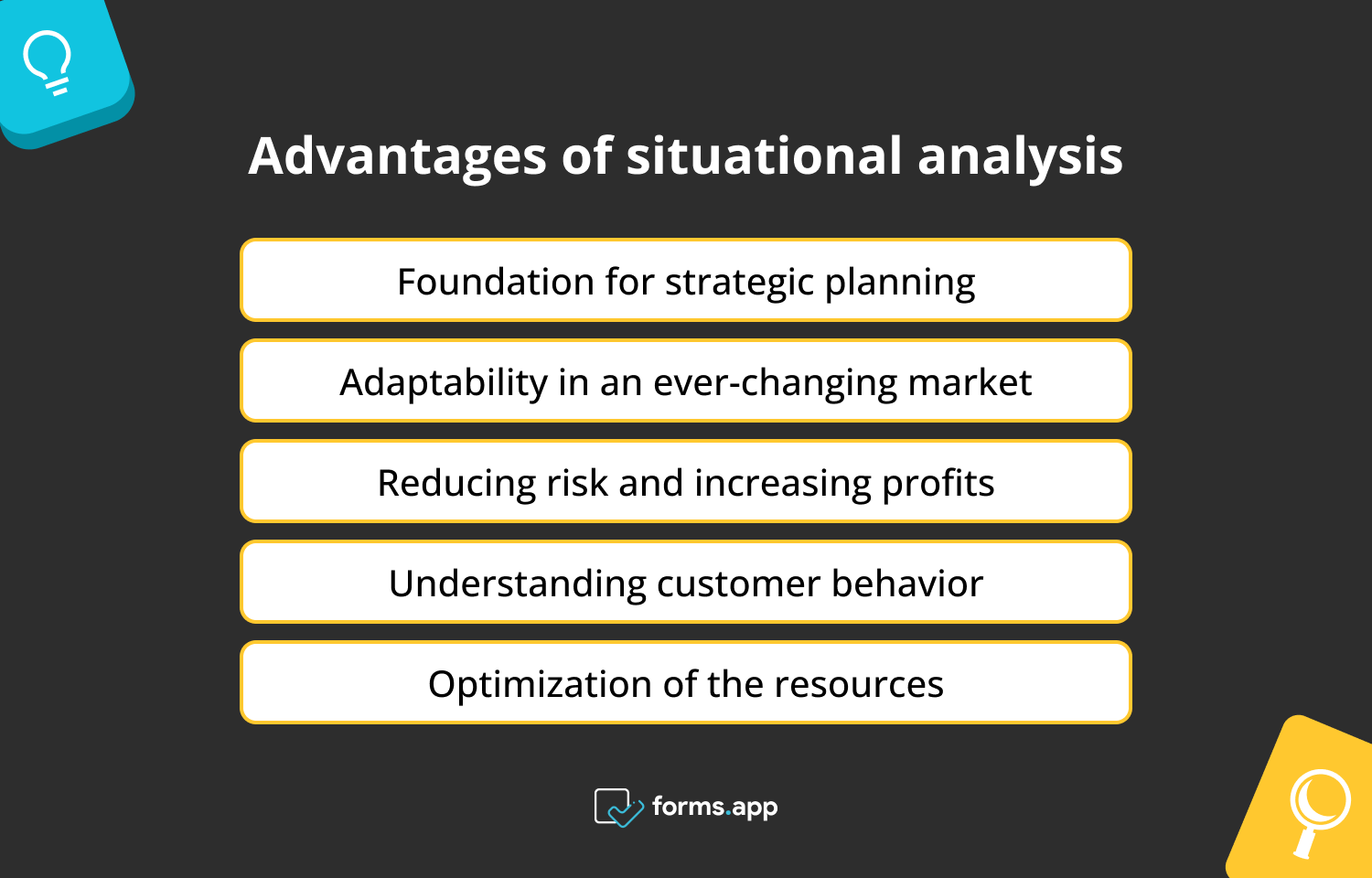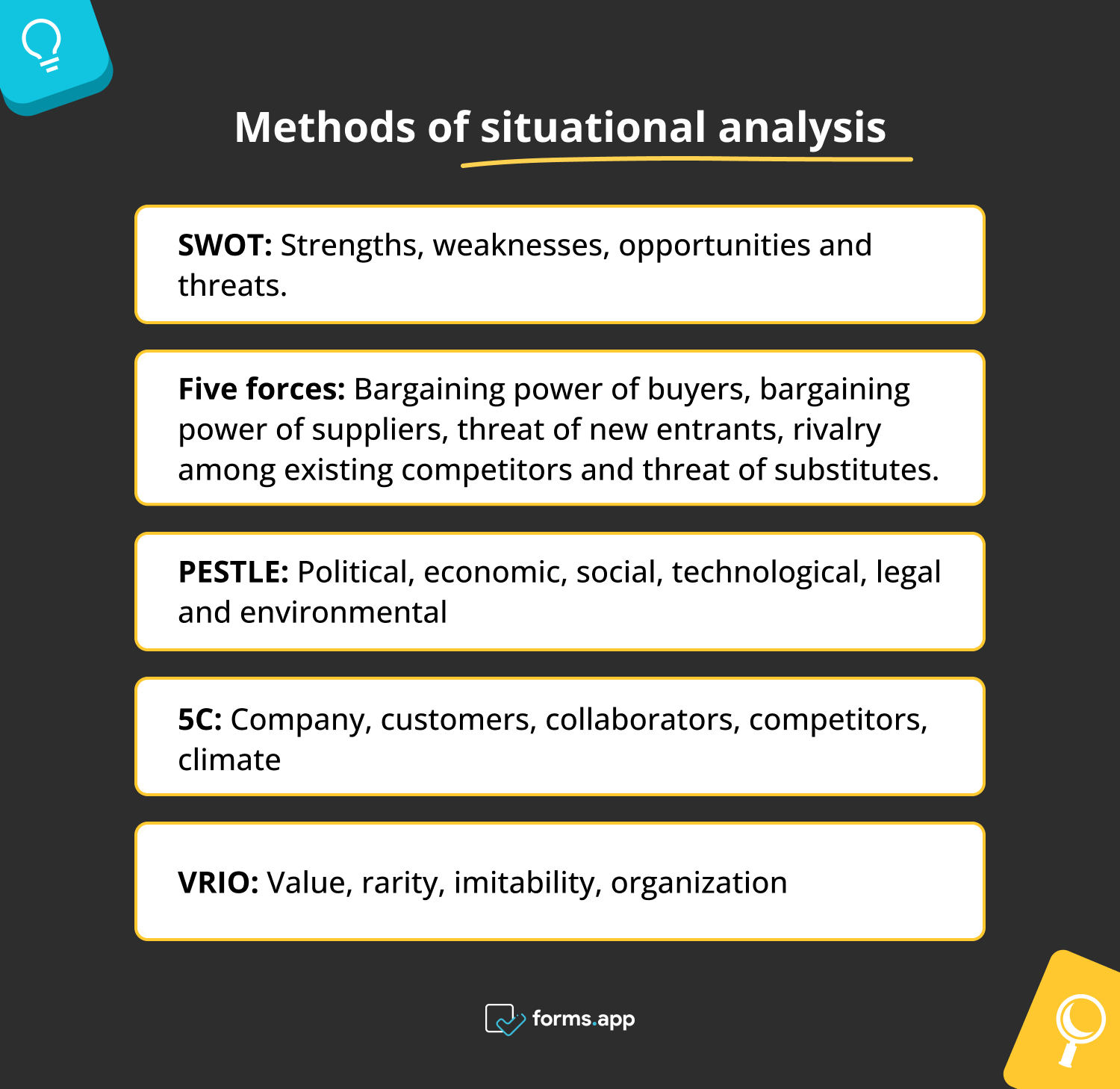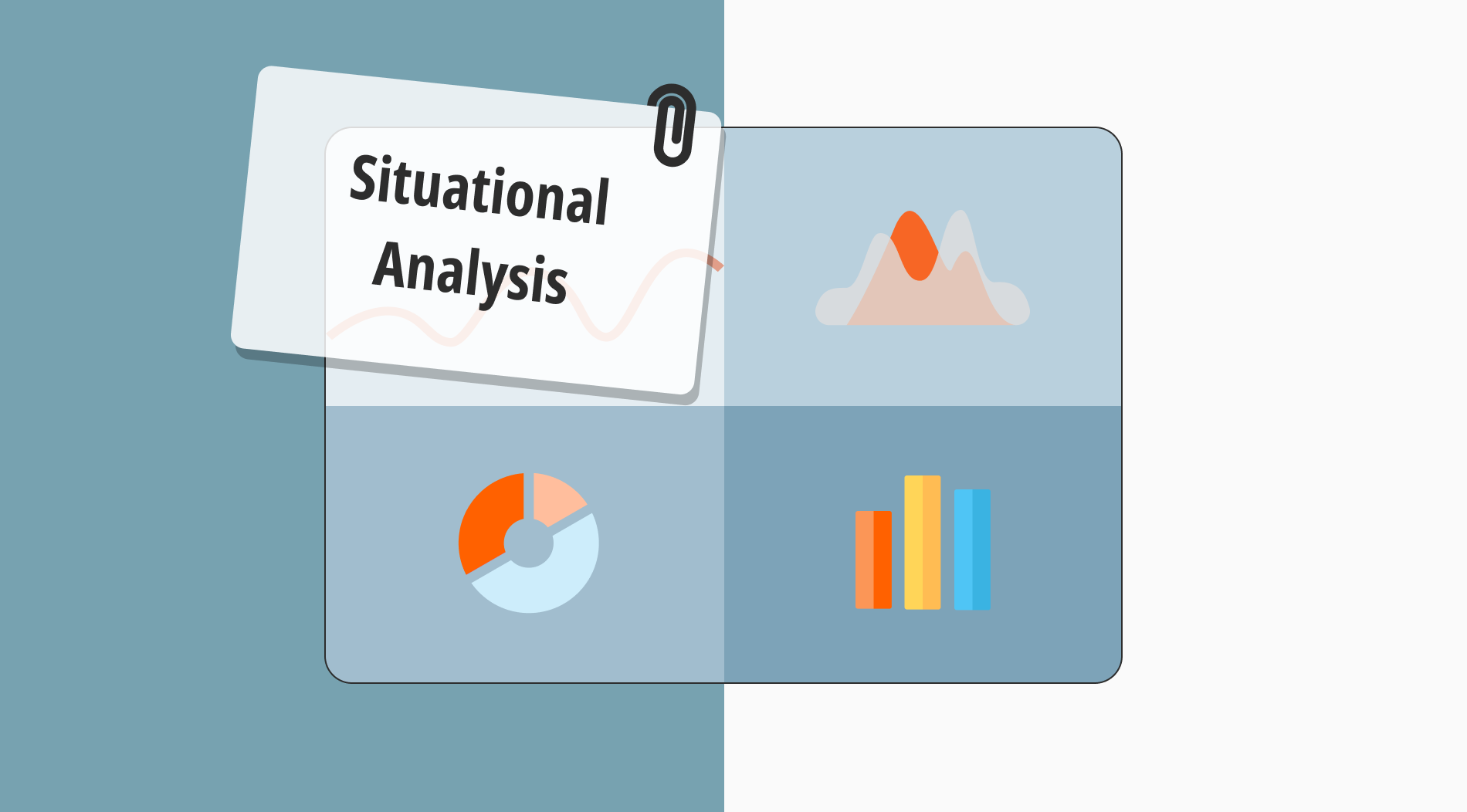Situational analysis is a reliable data-obtaining method widely used by businesses. As the name suggests, it is used to examine the internal and external factors of a company, business, or organization and produce valuable data. In other words, the result of this analysis ensures that you have the data to do whatever the situation requires.
Businesses undertake this type of analysis because it is an almost integral part of marketing. Those who want to make successful attempts or those who wish to continue their success often make this analysis. In our article, you will learn situational analysis with its definition, benefits, methods, and examples.
What is situational analysis?
Situational analysis is a type of analysis used to determine internal and external factors that affect the course of a company. It helps to determine vital strategic points for a company, especially strengths, weaknesses, opportunities, and threats (SWOT).
This analysis takes into account market trends, competitive environment, and organizational capabilities, allowing businesses to adapt to changing conditions and create practical plans for sustainable growth.
Why and when to use situational analysis?
Why? In short, you need it. And when? Almost always! Now, if these answers are explained in a broader context, you can also appreciate why you need to do situational analysis:
- It will help you in strategic planning and decision-making by detecting strengths, weaknesses, opportunities, and threats.
- It is an ideal way to reduce risks and increase profits.
And when should you use it? While it is crucial for always, you may need it more than sometimes. For example, major business milestones, such as when you:
- launch a product,
- enter a new market,
- or face a business challenge.
Advantages of situational analysis

Benefits of situational analysis
As mentioned in the paragraph above, there are reasonable grounds for performing a situational analysis. It is quite possible to bring your marketing, organizational internal flow, and development to a better level. If you want to examine these advantages in more detail, you can continue here:
- Foundation for strategic planning: It will enable you to be a successful and effective company in the long run.
- Adaptability in an ever-changing market: It allows you to get closer to the companies that dominate the market by adapting to new industry trends and customer preferences.
- Reducing risk and increasing profits: It helps you address challenges, mitigate risks, and take steps to turn this risk into profit.
- Understanding customer behavior: It will be very useful to benefit from such analysis to learn more about the most important thing for a business: customers.
- Optimization of the resources: Even if you cannot always find a profit and loss situation, this analysis will guide you in the right way to use resources sparingly.
Methods of situational analysis
Since situational analysis is a very rich type of analysis in terms of methods, it may seem a little challenging to choose the suitable method you target and need when doing it. However, as will be explained, these methods are more or less the same and are an essential building block to strengthen your business or organization. Here are five methods of situational analysis:

Situational analysis methods
1. SWOT analysis
SWOT analysis is a well-known situational analysis method that allows businesses to get insights into their strengths, weaknesses, opportunities, and threats.
Strengths: Any positive developments about your business are examined in detail here.
Weaknesses: It plays a role in determining areas that need improvement in your business.
Opportunities: It encourages various breakthroughs by revealing opportunities.
Threats: It aims to reveal any bad factors that could harm the health of your business.
2. Five forces analysis
Michael Porter developed this method, and it allows your business to check the industry’s competitive forces in detail.
Bargaining power of buyers: Rather than seeing buyers as an external factor, you should consider them as an important factor inherent in the business. Consider the possibility that buyers are not just individuals who consume your products but also individuals who can defend them and desire their continuation and improvement. Therefore, it is beneficial for your business to satisfy them in every sense.
Bargaining power of suppliers: Just like customers, suppliers are one of the cornerstones of your business. The relationships with suppliers can be a critical factor for a sustainable business life. Because they also represent the influence and importance of collaborators and critical partners.
Threat of new entrants: New entrants are not always your competitors; in fact, when you understand them well, you can see them as an element that plays an important role in the development and transformation of your business. New entrants ensure that your business remains alive and that the dead skin on your organization is constantly removed.
Rivalry among existing competitors: Again, you can assume existing competitors, such as new entrants, are partners of a large market ecosystem. Collaborating with your competitors when necessary and undertaking joint ventures and research is a very common behavior in the business world.
Threat of substitutes: Substitutes also constitute a significant part of the market. Analysis of them and their customers can be a lesson that teaches you what you can do differently.
3. PESTLE analysis
PESTLE analysis generally examines six external factors surrounding a business. Considering these factors, you can develop better marketing strategies. PESTLE stands for:
Political: A business gets its share from the political winds of the country it operates in. It is essential to consider the government's perspective and ideals.
Economic: It will be beneficial for your business to consider many economic factors, from inflation to economic development and unemployment.
Social: It is necessary to understand the members of society, such as the employees of your company or the customers your company targets.
Technological: It aims to follow technology and use it to your advantage. It is important, especially in today's rapidly changing technological world.
Legal: A business's actions have legal consequences, as wherever there is government, there will be law. And since these legal consequences will vary depending on the country you are in, understanding them is vital to avoid legal problems.
Environmental: There is also an environmental impact. This can include many issues, starting from logistics. That's why a good situation analysis is essential.
4. 5C analysis
5c analysis can be considered as an example of both internal and external situation analysis. Again, like other methods, this analysis is a step you can use to strengthen your place in the market. 5C stands for:
Company: Internal factors like resources, capabilities, and organizational structure
Customers: Behaviors and preferences of customers
Collaborators: Business partners, suppliers and distributors
Competitors: Current and potential competitors
Climate: External factors like PESTLE analysis
5. VRIO analysis
VRIO analysis consists of four criteria. If a source gets positive results from these four criteria, it means that that source is reliable for your business. Its advantage is that it provides analysis from a different perspective than other analysis types. VRIO stands for:
Value: Examine whether the resources add value to the company’s products or services.
Rarity: Check whether your resource is unique to your business.
Imitability: Gauge whether competing companies can imitate your source.
Organization: Understand how effective your organization is at using the resource.
Examples of situational analysis
If you are new to analysis or business, you can understand it better if you see some situational analysis examples. Three situation analysis marketing examples below are some situations you can encounter in your business life.
Example #1: Consider you are a company aiming to launch a new product in an ever-changing market, so you need to use situational analysis. Conduct a comprehensive PESTLE and Five Forces analyses to learn the regulatory environment, potential customers, and competitors. In this way, you will learn in which situations, when, and where you can release your product.
Example #2: Consider you want to conclude a cooperation agreement with another company. For a better synergy, it will be necessary to determine the weaknesses and strengths of both yourself and the other company.
Example #3: Consider you are going to expand your business to a new country. It may be dangerous to engage in such a move without first analyzing the situation of the country you will expand.
Frequently asked questions about situational analysis
You can check the places that we did not include in our main article or that you may have missed from the frequently asked questions here. Although the answers do not have comprehensive explanations, they will provide you with information in general terms.
The first one is SWOT analysis, which is an abbreviation for strengths, weaknesses, opportunities, and threats. The second one is PESTLE analysis, which assesses political, economic, social, technological, legal, and environmental factors. The third one is the five forces analysis developed by Michael Porter, which are the bargaining power of buyers and suppliers, the threat of new entrants, rivalry among existing competitors, and the threat of substitutes.
No, a SWOT analysis is not the same as a situation analysis. It is a component of situational analysis.
Determine the scope, identify internal and external factors, conduct the analysis, check the data and summarize key findings, recommend strategies, and initiate your plans.
As in every analysis, obtaining the correct data and interpreting it correctly in the situational analysis are the first challenges that come to mind. Because when you get these two main elements wrong, you cannot have a view of either the future or the current situation of your business.
Final words
In this article, answers to questions such as what situational analysis is in general and why, where, and when it should be used were given. Many methods and examples were presented to reinforce the subject, making it ready for you to conduct situational analysis competently. From now on, you can gain a competitive advantage in this market environment and have a prosperous organization in the long term.
Atakan is a content writer at forms.app. He likes to research various fields like history, sociology, and psychology. He knows English and Korean. His expertise lies in data analysis, data types, and methods.



